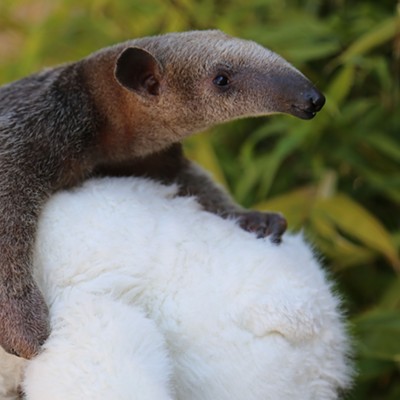Afternoon breezes whip trash across an empty parking lot and into the Quincie Douglas Pool's firmly locked gates.
Completed in 2006 at a cost topping $3 million, the 11,000-square-foot pool at 36th Street and Kino Parkway now sits idle nearly half the year. Even when Quincie is open from April through November, the calendar is dotted with employee-furlough days, when the gates remain closed, and lifeguards go unpaid.
Tucson's municipal pools are remarkably popular, welcoming an estimated 300,000 visitors each summer. But like Quincie, six of those full-size pools are shuttered through much of the winter. That's in addition to the 17 neighborhood pools that have been closed year-round, saving the city Parks and Recreation Department roughly $550,000 a year.
Billy Sassi is the city's longtime aquatics program manager. Speaking to the Tucson Weekly's Mari Herreras in 2010, he called the closures "very disheartening."
Two years later, various schemes are being floated to keep more of those pools open. For instance, Ward 5 City Councilman Richard Fimbres spearheaded a recent policy shift that allows Parks and Recreation to solicit private money for pool-funding. The jury is still out on whether the city will have to go begging.
Either way, Fimbres contends that the concept simply gives Parks and Recreation another revenue tool. "Although we're still in an economic downturn here, we do see a light at the end of the tunnel," he says. "But we're still trying to find new ways to get those pools open for the summer."
Until then, the pools enduring year-round closure include one at Reid Park. But unlike Quincie, you won't find silence at that midtown swimming hole. Instead, you're likely to hear the nearby grind of construction, as Parks and Recreation nears completion of its $9.7 million elephant exhibit at the Reid Park Zoo.
Roughly half of the money came from taxpayers. The remainder was provided through an ambitious fundraising effort, premised on enlarging the exhibit to keep the zoo's two longtime companion elephants together. Current plans, however, are to send both animals to the San Diego Zoo, where officials concede they'll likely be separated.
Meanwhile, operating Reid Park's new exhibit is expected to cost $400,000 annually. To many, that seems extravagant, particularly for a cash-strapped city department already faltering in its core services, such as keeping municipal pools open to the public.
But to Parks and Recreation director Fred Gray, the sum simply represents a commitment made by the City Council in 2005, when it approved the exhibit's expansion.
According to Gray, the vote carried a proviso that no additional day-to-day expenses would come from the city's general fund. Instead, the zoo planned to boost its entrance fees for the second time in a decade, by about 50 cents for kids, and $1 for adults. "We project that the new additional revenue will offset the (exhibit's) operating costs," he says.
Whether the new exhibit will really bump visitor revenues that significantly remains to be seen. In an earlier interview with the Tucson Weekly, zoo administrator Susan Basford seemed to dismiss exhibits as big money-makers. "We bring in through revenue about half of what it costs the city to operate the zoo," she said. "It's not a cash cow."
While Gray says the zoo's current $2.5 million budget was never meant to be self-sustaining, he notes that revenues have climbed to more than 50 percent, up from just 40 percent of operating costs a few years ago. "It's increased with time, because we've done some new exhibits. And one of the things that's driving attendance right now is new lion cubs."
All of which doesn't necessarily explain why Parks and Recreation appears to give priority to a few elephants, while thousands of swimmers remain locked out. "It's hard to rationalize a lot of things," Gray says. "But this master plan for the park expansion was done back in 2001, so it's been on the books for awhile.
"The thing I would say was that a commitment was made back in 2005. ...We're going to honor that commitment, but we still don't want general-fund money going toward that."
Of course, if the zoo hadn't expanded its exhibit, there would be no need to hike fees to pay for the expanded exhibit.
It doesn't help that said exhibit has been mired in controversy. The latest dust-up began when Reid Park officials pulled a grand flip-flop: After raising millions to enlarge the space with the goal of keeping longtime companion elephants Shaba and Connie together, they announced plans to instead fill the new exhibit with an African herd imported from the San Diego Zoo. In turn, the aging Asian Connie would be dispatched to San Diego.
Local activists undertook an effort to have both elephants relocated to a lush California wildlife sanctuary. They even persuaded former game-show impresario and animal-rights crusader Bob Barker to pledge $500,000 toward the move.
That option was immediately opposed by the Reid Park Zoo, which once again trotted out education curator Vivian VanPeenen. VanPeenen routinely labels detractors as "animal extremists." This time, she lashed out at Barker, claiming that his "only interest is his anti-zoo agenda."
In January, the zoo suddenly announced that both Connie and Shaba would be heading for San Diego. Not surprisingly, the timing of this latest about-face has proved curious indeed. Asked to explain, director Basford says, "We do constantly look at our decisions, and take into account the concerns of the citizens of Tucson. And we found a solution that wasn't really obvious to us early on, in consultation with the San Diego Zoo and the (Association of Zoos and Aquariums) and (a special) advisory group for African elephants."
Not obvious earlier?
"We've always let Reid Park know that we had space for two elephants," says Christina Simmons, a spokeswoman for the San Diego Zoo. "We have had the space for Shaba and Connie."
The San Diego Zoo is likely to have space, considering that one of its elephants killed another elephant in November; critics blame the tragedy on poor animal management. And in early January, two of the zoo's elephants were euthanized, one purportedly because of the complications of old age, the other because of an undetermined esophagus issue.
Not exactly an encouraging note for Connie and Shaba to exit on. Nor is the fact that they'll likely be separated soon after arrival in San Diego. "They'll be sent out together," says Basford. "We all collectively believe very strongly that Connie will gravitate to the Asian elephants, and Shaba will gravitate to the Africans."












